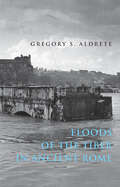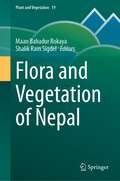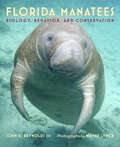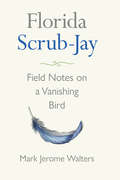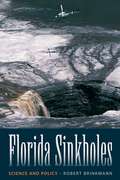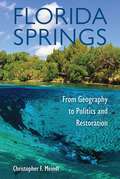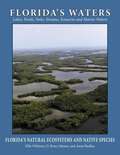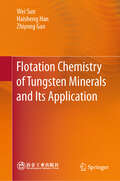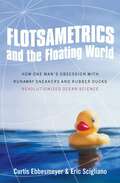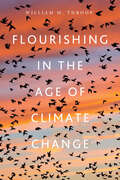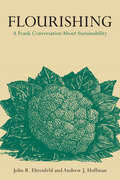- Table View
- List View
Floods in a Changing Climate
by P. P. Mujumdar D. Nagesh KumarVarious modeling methodologies are available to aid planning and operational decision making: this book synthesises these, with an emphasis on methodologies applicable in data scarce regions, such as developing countries. Problems included in each chapter, and supported by links to available online data sets and modeling tools, engage the reader with practical applications of the models. Academic researchers in the fields of hydrology, climate change, and environmental science and hazards, and professionals and policy-makers working in hazard mitigation, remote sensing and hydrological engineering will find this an invaluable resource. This volume is the second in a collection of four books on flood disaster management theory and practice within the context of anthropogenic climate change. The others are: Floods in a Changing Climate: Extreme Precipitation by Ramesh Teegavarapu, Floods in a Changing Climate: Inundation Modelling by Giuliano Di Baldassarre and Floods in a Changing Climate: Risk Management by Slodoban Simonović.
Floods in a Megacity
by Ashraf DewanFlooding is one of the most devastating natural hazards in the world. Available records suggest that both flood frequency and severity are on the rise and this is likely to worsen in the context of climate change. As population, infrastructure and poverty grow rapidly in developing countries, particularly in urban agglomerations of 10 million people or more, floods could cause widespread devastation, economic damage and loss of life. Assessment of vulnerability and risk from naturally occurring phenomena is therefore imperative in order to achieve urban sustainability. This book uses geospatial techniques to evaluate hazards, risk and vulnerability at a metropolitan scale in a data-scarce country. An empirical study was performed using remote sensing, GIS and census data. This research offers a new approach to mapping population, infrastructures and communities at risk which can greatly contribute to the deeper understanding of flood disasters in a rapidly expanding megacity. Examples shown in this book are from Dhaka Megacity, however, the techniques and methods can easily be implemented in medium to large cities of similar characteristics. The book is essential reading for hazard researchers, geospatial scientists, disaster management professionals, geographers, urban planners, and social scientists. Ashraf M. Dewan is currently a Lecturer in the Department of Spatial Sciences at Curtin University, Western Australia (on leave from his substantive position as Associate Professor in the Geography & Environment Department at the University of Dhaka, Bangladesh).
Floods in the Ganga–Brahmaputra–Meghna Delta (Springer Geography)
by Balai Chandra Das Sandipan Ghosh Aznarul Islam Pravat Kumar Shit Suvendu Roy Dilip Kumar Datta M. Shahidul IslamThis volume covers the floods of the major rivers of the Ganga-Brahmaputra-Meghna (GBM) Delta, and storm surge related coastal floods in these regions. The book is dedicated to addressing floods from an integrated physical-social perspective to provide students and researchers with a holistic understanding of floods in terms of both human and geomorphological aspects. The systematic coverage of all the major rivers and coastal areas in the GBM delta and surrounding regions will foster a clear comprehension of this dense reservoir of population, where thousands of people are impacted every year due to flood hazards and agricultural destabilization. This comprehensive treatment of flood issues in the region covers flash floods, fluvial floods, fluvio-tidal floods, and coastal floods, and outlines flood management strategies to maintain ecological integrity and environmental stability, and prevent harmful impacts of future floods. The book is intended for students and researchers in earth and environmental sciences, especially geomorphology, hydrology, geography, geology, natural resources management, and regional planning.
Floods of Northern New Jersey (Images of America)
by North Jersey Media Group Amre YoussefSituated between winding rivers and prone to turbulent storms, northern New Jersey has had an extensive and tumultuous history of flooding. The most severe flood occurred in 1903 when three days of nonstop rain, averaging 12 inches per day, melted more than 23 inches of snow and ice�inundating the cities of Passaic and Wallington and splitting Paterson in two. Since 1945, more than 60 documented storms have wreaked havoc and shaken the region. In 2011, the second-worst storm in North Jersey�s history, Hurricane Irene, struck with more than 11 inches of rain, displacing 6,000 residents in Paterson alone and hitting Bergen and Passaic Counties with a vengeance. Only one year later, Superstorm Sandy rolled into North Jersey, flooding Moonachie and Little Ferry with surges up to five feet. Floods of Northern New Jersey showcases the rich documentation of flooding through a unique and significant photographic collection.
Floods of the Tiber in Ancient Rome (Ancient Society and History)
by Gregory S. AldreteWhile the remains of its massive aqueducts serve as tangible reminders of Rome’s efforts to control its supply of drinking water, there are scant physical reminders that other waters sometimes raged out of control. In fact, floods were simply a part of life in ancient Rome, where proximity to the Tiber left a substantial part of the city vulnerable to the river's occasional transgressions. Here, in the first book-length treatment of the impact of floods on an ancient city, Gregory S. Aldrete draws upon a diverse range of scientific and cultural data to develop a rich and detailed account of flooding in Rome throughout the classical period.Aldrete explores in detail the overflowing river’s destructive effects, drawing from ancient and modern written records and literary accounts, analyses of the topography and hydrology of the Tiber drainage basin, visible evidence on surviving structures, and the known engineering methods devised to limit the reach of rising water. He discusses the strategies the Romans employed to alleviate or prevent flooding, their social and religious attitudes toward floods, and how the threat of inundation influenced the development of the city's physical and economic landscapes.
Floods of the Tiber in Ancient Rome (Ancient Society and History)
by Gregory S. AldreteA study of the impact of flooding on the ancient city during the classical period.While the remains of its massive aqueducts serve as tangible reminders of Rome’s efforts to control its supply of drinking water, there are scant physical reminders that other waters sometimes raged out of control. In fact, floods were simply a part of life in ancient Rome, where proximity to the Tiber left a substantial part of the city vulnerable to the river’s occasional transgressions.Here, in the first book-length treatment of the impact of floods on an ancient city, Gregory S. Aldrete draws upon a diverse range of scientific and cultural data to develop a rich and detailed account of flooding in Rome throughout the classical period.Aldrete explores in detail the overflowing river’s destructive effects, drawing from ancient and modern written records and literary accounts, analyses of the topography and hydrology of the Tiber drainage basin, visible evidence on surviving structures, and the known engineering methods devised to limit the reach of rising water. He discusses the strategies the Romans employed to alleviate or prevent flooding, their social and religious attitudes toward floods, and how the threat of inundation influenced the development of the city’s physical and economic landscapes.“Floods of the Tiber in Ancient Rome is that rare thing in scholarship, a work that genuinely fills a gap in the scholarly literature. Professor Aldrete has brilliantly illuminated an aspect of ancient Rome that was ever present to the city’s inhabitants but almost invisible to modern historians.” —Stanley Burstein, history teacher“Raises important questions about the effects of flooding of the Tiber on the city of ancient Rome and its inhabitants and explores why Romans did not take more sweeping steps to reduce, if not eliminate, the dangers of urban flooding. There is no comparable book-length study of this topic, so this work fills a real need. It will be of interest not only to students of ancient history, but to hydrologists and students of urban studies as well. Certainly it will give us classicists much to think about in our assessment of urban life in ancient Rome.” —Harry B. Evans, Fordham University, author of Aqueduct Hunting in the Seventeenth Century
Floods: British Policies For Hazard Reduction, Agricultural Improvement And Wetland Conservation (Routledge Library Editions: Conservation Ser. #5)
by D. J. ParkerFloods occur in most parts of the world and range from being welcomed annual occurrences, to natural disasters which have countless physical and societal impacts. Floods presents the most comprehensive collection to date of new research, providing a rich body of theory and experience and drawing together contributions from over fifty leading international researchers in the field. An extensive range of case-studies covering major floods and regions prone to flooding worldwide are included.
Floods: Extreme Weather (Theme Sets)
by Josie GreenExplains the causes of four different types of weather: droughts, floods, tornadoes, and hurricanes
Flora Fantastic: From Orchidelirium to Ecocritical Contemporary Art (ISSN)
by Corina L. Apostol Tashima ThomasThis book delves deep into colonial botany, utilizing mediums such as historical investigation, cinema, photography, live performance, and installation art.Surveying perspectives from Europe, the U.S., Africa, Southeast Asia, Latin America, and the Caribbean, it positions plants—both native and foreign—as active participants and silent observers in colonial narratives. By viewing through the prism of visual and performance art, this book touches on diverse topics like the economic value of plants, traditional and Western medicine, state‑endorsed scientific endeavors, migration patterns of flora and people, bio‑contact areas, nationalistic views, and botanical diplomacy. It offers fresh insights into colonial botany’s multifaceted history, emphasizing the intricate interplay between Eastern, Western, and Southern nations during the twentieth century and its enduring impact today.Serving as an invaluable addition to the realms of art history, performance studies, botany, visual culture, decolonial initiatives, and environmental politics, this book arrives at a pivotal moment when its insights are most crucial.
Flora and Vegetation of Nepal (Plant and Vegetation #19)
by Maan Bahadur Rokaya Shalik Ram SigdelThis volume highlights the plant life of Nepal, which accounts for 20% of the Himalayan biodiversity. For the first time, this group of authors compile over 200 years’ worth of local botanical research. Due to the high topographical diversity, Nepal has a very unique flora and vegetation. The chapters focus on cryptogams, phanerogams and alien flora. As an added bonus, historical background for native and invasive species, is explained. Aside from botanical knowledge, the authors also shed a light on Nepali geography, soil, climate and land use. To complete the picture, readers will find data on different plants, maps and photographs of unique species. This book is a valuable resource for Botanists and Ecologists, but also for interested travelers who would like to complement their next trek in Nepal.
Florida Bay Research Programs And Their Relation To The Comprehensive Everglades Restoration Plan
by Committee on Restoration of the Greater Everglades EcosystemThe National Academies Press (NAP)--publisher for the National Academies--publishes more than 200 books a year offering the most authoritative views, definitive information, and groundbreaking recommendations on a wide range of topics in science, engineering, and health. Our books are unique in that they are authored by the nation's leading experts in every scientific field.
Florida Manatees: Biology, Behavior, and Conservation
by John E. Reynolds IIIA photographic journey into the secret world of Florida’s beloved manatee.Winner of the CHOICE Outstanding Academic Title of the Choice ACRLManatees, the gentle giants of Florida's lagoons and coastal habitats, can bring a smile to the face of anybody lucky enough to spy one. As manatees dip and roll through the water, crowds gather to watch them feed on aquatic vegetation. Whether they are congregating by the hundreds or resting or feeding alone, viewing these sea cows can provide anyone interested in nature with hours of tranquil pleasure.Having survived for eons, today's manatees are now under constant threat due to our rapidly swelling human population. Their habitats are often devastated by development and pollution. The slow-moving manatees also live at the mercy of chance, for they occupy waters filled with fast-moving boats powered by razor-sharp propellers—a new form of predator from which they have no protection. Boat speed limits have been put in place to protect manatees, but there is a constant push to lift them so that people can once again zip across the waters that manatees call home. For this reason, manatees are often a subject of controversy that pits their lives against the rights of boat owners. In this book, manatee expert John E. Reynolds III and famed photographer Wayne Lynch join forces to reveal the clearest portrait of manatees ever published. Florida Manatees is a song for the manatee, a celebration of the lives of these majestic creatures. Reynolds's concise, informative text shares what scientists know about manatees, while Lynch's beautiful photographs instantly demonstrate how special these "potatoes with whiskers" really are. By encouraging an appreciation of manatees, the authors hope to help ensure a future in which Floridians can find ways to coexist with and continue to enjoy these uniquely wonderful sirenian inhabitants of their state.Included in this book: How manatees first came to Florida waters How manatees fit into the ecosystems of Florida What and how much manatees eat How manatees behave and communicate with one another Why manatees look the way they do Why manatees have whiskers How manatee mothers feed their young and much more
Florida Manatees: Biology, Behavior, and Conservation
by John E. Reynolds IIIA photographic guide that “focuses on the beauty, grace and vulnerability of these herbivores, but it also covers other sea mammals and their habitats” (The Biologist).Named a Choice Outstanding Academic TitleIn this book, manatee expert John E. Reynolds III and famed photographer Wayne Lynch join forces to reveal the clearest portrait of manatees ever published. Florida Manatees is a song for the manatee, a celebration of the lives of these majestic creatures. Reynolds’s concise, informative text shares what scientists know about manatees, while Lynch’s beautiful photographs instantly demonstrate how special these “potatoes with whiskers” really are. By encouraging an appreciation of manatees, the authors hope to help ensure a future in which Floridians can find ways to coexist with and continue to enjoy these uniquely wonderful sirenian inhabitants of their state.Included in this book:How manatees first came to Florida watersHow manatees fit into the ecosystems of FloridaWhat and how much manatees eatHow manatees behave and communicate with one anotherWhy manatees look the way they doWhy manatees have whiskersHow manatee mothers feed their young and much more“A lovely book that sounds as though it would appeal primarily to scientists, but which offers inviting color photos and history that make it accessible to lay audiences both within Florida and outside the state.” —Donovan’s Literary Services
Florida Scrub-Jay: Field Notes on a Vanishing Bird
by Mark Jerome WaltersA portrait of a species on the brink The only bird species that lives exclusively in Florida, the Florida scrub-jay was once common across the peninsula. But as development over the last 100 years reduced the habitat on which the bird depends from 39 counties to three, the species became endangered. With a writer’s eye and an explorer’s spirit, Mark Walters travels the state to report on the natural history and current predicament of Florida’s flagship bird.Tracing the millions of years of evolution and migration that led to the development of songbirds and this unique species of jay, Walters describes the Florida bird’s long, graceful tail, its hues that blend from one to the next, and its notoriously friendly manner. He then focuses on the massive land-reclamation and canal-building projects of the twentieth century that ate away at the ancient oak scrub heartlands where the bird was abundant, reducing its population by 90 percent.Walters also investigates conservation efforts taking place today. On a series of field excursions, he introduces the people who are leading the charge to save the bird from extinction—those who gather for annual counts of the species in fragmented and overlooked areas of scrub; those who relocate populations of scrub-jays out of harm’s way; those who survey and purchase land to create wildlife refuges; and those who advocate for the prescribed fires that keep scrub ecosystems inhabitable for the species.A loving portrayal of a very special bird, Florida Scrub-Jay is also a thoughtful reflection on the ethical and emotional weight of protecting a species in an age of catastrophe. Now is the time to act, says Walters, or we will lose the scrub-jay forever.
Florida Sinkholes: Science and Policy
by Robert BrinkmannBelow the live oaks, palm trees, cypress swamps, and springs, water is slowly wearing away the limestone bedrock of Florida. The erosion is often unseen, and over time it can result in shocking cave-ins like the destructive spectacle of the 1981 Winter Park sinkhole.Florida Sinkholes--the first comprehensive book on the subject--is an easy-to-follow guide to understanding how sinkholes form and what to do about Florida's sometimes pockmarked landscape. City planners, construction managers, developers, and homeowners alike will find this book invaluable because of the heavy impact and increasing frequency of sinkhole formation in the state. Amateur geologists will be fascinated by the subtle forces of nature that can make solid rock disappear. Tackling the problem of sinkholes in useful detail, this book packs an abundance of sound scientific fact into frank, readable language. Learn about the captivating workings of karst, a term for the swiss cheese-like formations of soluble rock that underlie the peninsula. Discover current state-of-the-art approaches to mapping sinkholes and subsurface voids. Review such practical concerns as structural damage, repairs, insurance problems, and management of karst lands. Examine case studies of several notable sinkholes and sinkhole events. Even before you've finished reading, you may find yourself itching to get out and visit these intriguing marvels of Florida geology for yourself.
Florida Springs: From Geography to Politics and Restoration
by Christopher F. MeindlThis book provides a clear and comprehensive overview of the geography, history, science, and politics of Florida’s freshwater springs, informing readers about the deep past and current issues facing these natural wonders of the state.
Florida's Uplands (Florida's Natural Ecosystems and Native Species)
by Ellie Whitney Anne Rudloe D Bruce MeansTaken from the earlier book Priceless Florida (and modified for a stand-alone book), this volume discusses the well-drained areas of Florida, including high pine grasslands, flatwoods and prairies, interior scrub, hardwood hammocks, rocklands and caves, and beach dunes. Introduces readers to the trees and plants, insects, mammals, reptiles, and other species that live in Florida's unique uplands ecosystem.Next in series > >See all of the books in this series
Florida's Waters (Florida's Natural Ecosystems and Native Species)
by Ellie Whitney Anne Rudloe D Bruce MeansTaken from the earlier book Priceless Florida (and modified for a stand-alone book), this volume discusses the fresh- and saltwater systems of Florida, including lakes and ponds; rivers and streams; springs; aquatic caves; estuarine waters and seafloors; submarine meadows, sponge, rock, and reef communities; and the Gulf and Atlantic Ocean. Introduces readers to the trees and plants, insects, mammals, reptiles, and other species that live in Florida's unique water ecosystems, including chicken turtle, barking treefrogs, osprey, herons, bass, crayfish, conchs, cordgrass, and railroad vine. Discusses the food chain and the interconnectedness of all species.See all of the books in this series
Florida's Wetlands (Florida's Natural Ecosystems and Native Species)
by Ellie Whitney Anne Rudloe D Bruce MeansTaken from the earlier book Priceless Florida (and modified for a stand-alone book), this volume discusses Florida's wetlands, including interior wetlands, seepage wetlands, marshes, flowing-water swamps, beaches and marine marshes, and mangrove swamps. Introduces readers to the trees and plants, insects, mammals, reptiles, and other species that live in Florida's unique wetlands ecosystem, including the Virginia iris, American white waterlily, cypress, treefrogs, warblers, and the Florida black bear.Next in series > >See all of the books in this series
Flotation Chemistry of Tungsten Minerals and Its Application
by Wei Sun Haisheng Han Zhiyong GaoThis book provides an in-depth examination of the geological and metallogenic mechanisms, crystal chemistry, and solution chemistry of tungsten ore. The novel findings presented herein establish a robust foundation for the design and development of specialized flotation reagents and innovative flotation processes tailored specifically for tungsten ore. Moreover, this work constructs a comprehensive theoretical framework of tungsten ore flotation chemistry, significantly advancing new technologies in this domain. The content of this book will be of considerable interest to university faculty, researchers, R&D engineers, and graduate students in the fields of mineral processing and extractive metallurgy. It offers valuable insights into cutting-edge reagents and technologies that enhance energy efficiency and promote environmental sustainability.
Flotsametrics and the Floating World: How One Man's Obsession with Runaway Sneakers and Rubber Ducks Revolutionized Ocean Science
by Eric Scigliano Curtis Ebbesmeyer“Ebbesmeyer’s goal is noble and fresh: to show how the flow of ocean debris around the world reveals ‘the music’ of the world’s oceans.”—New York Times Book ReviewThrough the fascinating stories of flotsam, one of the Earth’s greatest secrets is revealed. In Flotsametrics and the Floating World, maverick scientist Curtis Ebbesmeyer details how his obsession with floating garbage—from rubber ducks to discarded Nike sneakers—helped to revolutionize ocean science. Scientist and environmentalist David Suzuki, host of CBC TV’s “The Nature of Things,” calls Flotsametrics and the Floating World “Science and storytelling at its very best.” “A very enjoyable, if at times dark, book” (Nature), it is must reading for anyone interested in Oceanography, Environmental Science, and the way our world works.
Flourish by Design
by Leon Cruickshank Nick Dunn Gemma CoupeFlourish by Design brings together a range of established and emerging voices in design research for a collection that provides original provocations on topics of global significance. It is an insightful guide to original theory and practice concerning how we can design for a better tomorrow. Featuring contributors from a diverse array of backgrounds and professions, this edited book explores the difference that design and design research can make for people, organisations, and the planet to prosper now and in the future. It offers a range of ideas and techniques through practical examples and ongoing projects showing how applied design research can respond to global challenges. Covering topics as diverse as artificial intelligence, bio-inspired materials, more-than-human design, sustainability, and urban acupuncture, it shares interdisciplinary and transdisciplinary design research not just to demonstrate what could be plausible in the near future but also to explain why it might be preferable. By sharing these despatches, this collection represents the very best of what design research can do, explaining how and why. This book is intended for a wide audience of professionals, scholars, and students in design, architecture, and public policy, as well as anyone who has an interest in how we design the world and, in turn, it designs us. The Open Access version of this book, available at www.taylorfrancis.com, has been made available under a Creative Commons Attribution-Non Commercial-No Derivatives (CC-BY-NC-ND) 4.0 license
Flourishing Within Limits to Growth: Following nature's way
by Sven Erik Jørgensen Brian D. Fath Søren Nors Nielsen Federico M. Pulselli Daniel A. Fiscus Simone BastianoniDecades of research and discussion have shown that the human population growth and our increased consumption of natural resources cannot continue – there are limits to growth. This volume demonstrates how we might modify and revise our economic systems using nature as a model. The book describes how nature uses three growth forms: biomass, information, and networks, resulting in improved overall ecosystem functioning and co-development. As biomass growth is limited by available resources, nature uses the two other growth forms to achieve higher resource use efficiency. Through a universal application of the three ‘R’s: reduce, reuse, and recycle, nature thus shows us a way forward towards better solutions. However, our current approach, dominated by short-term economic thinking, inhibits full utilization of the three ‘R’s and other successful approaches from nature. Building on ecological principles, the authors present a global model and futures scenario analyses which show that implementation of the proposed changes will lead to a win-win situation. In other words, we can learn from nature how to develop a society that can flourish within the limits to growth with better conditions for prosperity and well-being.
Flourishing in the Age of Climate Change
by William M. ThroopFlourishing in the Age of Climate Change explores skills we need to successfully navigate the distinctive environmental, social, and economic challenges of the twenty-first century. Our inability to address increasing resource constraints, social conflict, and ecological decline lead many toward a deep pessimism that saps motivation for change. Drawing on research from environmental science, ethics, psychology, sociology and educational theory, William M. Throop shows why cultivating underdeveloped skills involved in collaboration, humility, frugality and systems thinking can enable flourishing within our context. He also illustrates how we can strengthen such skills individually and how education can scale up their cultivation, which will be essential for achieving sustainability. Flourishing in the Age of Climate Change is a hopeful, practical resource for readers passionate about creating a world where we can thrive, and where flourishing is widespread.
Flourishing: A Frank Conversation About Sustainability
by Andrew J. Hoffman John R. EhrenfeldFlourishing: A Frank Conversation about Sustainability invites you into a conversation between a teacher, John R. Ehrenfeld, and his former student now professor, Andrew J. Hoffman, as they discuss how to create a sustainable world. Unlike virtually all other books about sustainability, this one goes beyond the typical stories that we tell ourselves about repairing the environmental damages of human progress. Through their dialogue and essays that open each section, the authors uncover two core facets of our culture that drive the unsustainable, unsatisfying, and unfair social and economic machines that dominate our lives. First, our collective model of the way the world works cannot cope with the inherent complexity of today's highly connected, high-speed reality. Second, our understanding of human behavior is rooted in this outdated model. Driven by the old guard, sustainability has become little more than a fashionable idea. As a result, both business and government are following the wrong path—at best applying temporary, less unsustainable solutions that will fail to leave future generations in better shape. To shift the pendulum, this book tells a new story, driven by being and caring, as opposed to having and needing, rooted in the beauty of complexity and arguing for the transformative cultural shift that we can make based on our collective wisdom and lived experiences. Then, the authors sketch out the road to a flourishing future, a change in our consumption and a new approach to understanding and acting. There is no middle ground; without a sea change at the most basic level, we will continue to head down a faulty path. Indeed, this book is a clarion call to action. Candid and insightful, it leaves readers with cautious hope.




